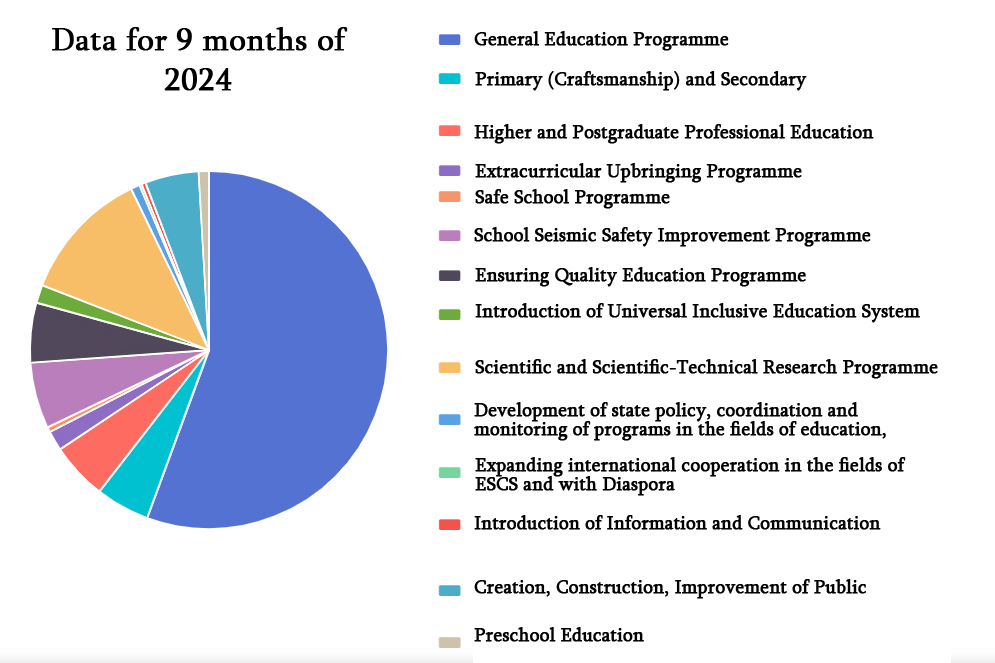What Changes has the Education Budget undergone since the Introduction of Standards? Specialist about the Funded and Terminated Programmes
Back on 16 March, 2023, the Government of the Republic of Armenia approved The Action Plan arising from the Law “On Approving the State Programme for the Development of Education in the Republic of Armenia until 2030”.
Following the introduction of the standard, institutional changes aimed to improve the quality of education took place. Within the framework of these changes the education budget was distributed for the implementation of a number of programmes.
What changes has the education budget undergone since the introduction of the standard? Which activities have received more investment and which have not?
In an interview with Iravaban.net, Ms Elena Harutyunyan, a young specialist in budgetary issues of the “Budgets for Citizens” Programme implemented by a consortium of CSOs under the leadership of the “Armenian Lawyers’ Association” NGO, notes that the Draft Budget for 2024 envisaged implementation of 14 programmes.
In addition to the programmes implemented in previous years, programmes for the creation, construction, and improvement of public educational and preschool institutions as well as the Preschool Education Programme have been added.
According to the specialist the expenditures of the education sector have increased significantly after the introduction of the new standards. According to the annexes to the Law on the State Budget, the 2024 budget for programmes and measures amounted to AMD 316.8 bln, which is an increase of 59.7%.
“These changes are related to the implementation of STEM education and the development of robotics in schools, participation in the Programme for International Student Assessment (PISA) since 2023, and measures aimed to increase the salaries of teachers in the field of STEM (except mathematics) ) in all state general education institutions of the Republic of Armenia. Great attention is paid to improving the professional qualifications of teachers through providing a category qualification through voluntary attestation,” she said.
(Figure from https://mediaforedu.am/armenian-educational-expenses/)
Figure 6

While examining the budget allocated to the Education Sector for 2024, it is noticeable that the measure Implementation of the subject “National Song and Dance” in general education institutions did not receive funding in the Draft Budget for 2024.
Iravaban.net contacted the MoESCS with a request to clarify what necessary measures the Ministry is trying to implement in 2025 to solve the problem and whether there is any statistical data on how many schools currently teach this subject and how many do not.
In addition, what is the Ministry’s position on the continuous teaching of the subject in the general education schools, and whether this will have an impact on the teachers of the mentioned subjects?
In response to our request, we were informed that the new State Standard of General Education was approved by the RA Government Resolution No. 136-N dated 4 February, 2021, and that one of the 7 educational areas of the General Education Programme defined in paragraph 15 is the “Arts and Crafts” area.
It is implemented through the active application of interdisciplinary connections, through communication between different types of art and folk crafts, through independent artistic and creative activities, and contributes to communication with folk traditions and cultural heritage.
The Ministry also reported that in parallel with the introduction of the New State Standard of General Education, the subject “National Song and Dance” is being taught in the General Education Institutions within the framework of the group of subjects defined by the subject standard for the educational field “Arts and Crafts”.
The “Arts and Crafts” field is presented in grades 1-12 of the State Programme of General Education within the framework of the academic subjects of Music, Fine Arts, Dance, Theatre, and Decorative and Applied Arts (DAA), in elementary, middle, and high schools, as a separate or integrated course.
Accordingly, the funding of the measure is included within the framework of funding of the above-mentioned subject group.
“At the same time, we also inform that teachers of music or fine arts, or teachers who have undergone appropriate training in any area of art, have the opportunity to teach the integrated subject “Art” in general education institutions,” the MoESCS added.
Details in the video.
